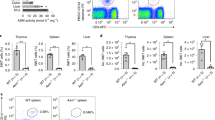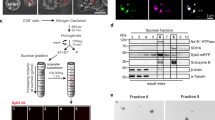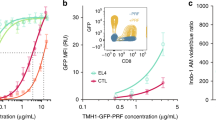Abstract
Granule-mediated cytotoxicity is the main effector mechanism of cytotoxic CD8+ T cells. We report that CD8+ T cells from acid sphingomyelinase (ASMase)-deficient (ASMase-KO) mice are defective in exocytosis of cytolytic effector molecules; this defect resulted in attenuated cytotoxic activity of ASMase-KO CD8+ T cells and delayed elimination of lymphocytic choriomeningitis virus from ASMase-KO mice. Cytolytic granules of ASMase-KO and wild-type CD8+ T cells were equally loaded with granzymes and perforin, and correctly directed to the immunological synapse. In wild-type CD8+ T cells, secretory granules underwent shrinkage by 82% after fusion with the plasma membrane. In ASMase-KO CD8+ T cells, the contraction of secretory granules was markedly impaired. Thus, ASMase is required for contraction of secretory granules and expulsion of cytotoxic effector molecules.
This is a preview of subscription content, access via your institution
Access options
Subscribe to this journal
Receive 12 print issues and online access
$209.00 per year
only $17.42 per issue
Buy this article
- Purchase on Springer Link
- Instant access to full article PDF
Prices may be subject to local taxes which are calculated during checkout








Similar content being viewed by others
References
Stinchcombe, J.C. & Griffiths, G.M. Secretory mechanisms in cell-mediated cytotoxicity. Annu. Rev. Cell Dev. Biol. 23, 495–517 (2007).
Henkart, P.A., Williams, M.S., Zacharchuk, C.M. & Sarin, A. Do CTL kill target cells by inducing apoptosis? Semin. Immunol. 9, 135–144 (1997).
Peters, P.J. et al. Cytotoxic T lymphocyte granules are secretory lysosomes, containing both perforin and granzymes. J. Exp. Med. 173, 1099–1109 (1991).
Raja, S.M., Metkar, S.S. & Froelich, C.J. Cytotoxic granule-mediated apoptosis: unraveling the complex mechanism. Curr. Opin. Immunol. 15, 528–532 (2003).
Clark, R.H. et al. Adaptor protein 3-dependent microtubule-mediated movement of lytic granules to the immunological synapse. Nat. Immunol. 4, 1111–1120 (2003).
Stinchcombe, J.C., Bossi, G., Booth, S. & Griffiths, G.M. The immunological synapse of CTL contains a secretory domain and membrane bridges. Immunity 15, 751–761 (2001).
Haddad, E.K., Wu, X., Hammer, J.A. III & Henkart, P.A. Defective granule exocytosis in Rab27a-deficient lymphocytes from Ashen mice. J. Cell Biol. 152, 835–842 (2001).
Ménasché, G. et al. Mutations in RAB27A cause Griscelli syndrome associated with haemophagocytic syndrome. Nat. Genet. 25, 173–176 (2000).
Jahn, R., Lang, T. & Sudhof, T.C. Membrane fusion. Cell 112, 519–533 (2003).
Feldmann, J. et al. Munc13-4 is essential for cytolytic granules fusion and is mutated in a form of familial hemophagocytic lymphohistiocytosis (FHL3). Cell 115, 461–473 (2003).
Menager, M.M. et al. Secretory cytotoxic granule maturation and exocytosis require the effector protein hMunc13-4. Nat. Immunol. 8, 257–267 (2007).
Chernomordik, L.V. & Kozlov, M.M. Protein-lipid interplay in fusion and fission of biological membranes. Annu. Rev. Biochem. 72, 175–207 (2003).
Holopainen, J.M., Subramanian, M. & Kinnunen, P.K. Sphingomyelinase induces lipid microdomain formation in a fluid phosphatidylcholine/sphingomyelin membrane. Biochemistry 37, 17562–17570 (1998).
Krönke, M. Biophysics of ceramide signaling: interaction with proteins and phase transition of membranes. Chem. Phys. Lipids 101, 109–121 (1999).
Goni, F.M. & Alonso, A. Sphingomyelinases: enzymology and membrane activity. FEBS Lett. 531, 38–46 (2002).
Bollinger, C.R., Teichgraber, V. & Gulbins, E. Ceramide-enriched membrane domains. Biochim. Biophys. Acta 1746, 284–294 (2005).
Merrill, A.H. Jr. & Jones, D.D. An update of the enzymology and regulation of sphingomyelin metabolism. Biochim. Biophys. Acta 1044, 1–12 (1990).
Schissel, S.L., Keesler, G.A., Schuchman, E.H., Williams, K.J. & Tabas, I. The cellular trafficking and zinc dependence of secretory and lysosomal sphingomyelinase, two products of the acid sphingomyelinase gene. J. Biol. Chem. 273, 18250–18259 (1998).
Futerman, A.H. & Riezman, H. The ins and outs of sphingolipid synthesis. Trends Cell Biol. 15, 312–318 (2005).
Holthuis, J.C. & Levine, T.P. Lipid traffic: floppy drives and a superhighway. Nat. Rev. Mol. Cell Biol. 6, 209–220 (2005).
Holopainen, J.M., Angelova, M.I. & Kinnunen, P.K. Vectorial budding of vesicles by asymmetrical enzymatic formation of ceramide in giant liposomes. Biophys. J. 78, 830–838 (2000).
Lehmann-Grube, F., Assmann, U., Löliger, C., Moskophidis, D. & Löhler, J. Mechanism of recovery from acute virus infection. I. Role of T lymphocytes in the clearance of lymphocytic choriomeningitis virus from spleens of mice. J. Immunol. 134, 608–615 (1985).
Moskophidis, D. & Lehmann-Grube, F. Virus-induced delayed-type hypersensitivity reaction is sequentially mediated by CD8+ and CD4+ T lymphocytes. Proc. Natl. Acad. Sci. USA 86, 3291–3295 (1989).
Lowin, B., Mattman, C., Hahne, M. & Tschopp, J. Comparison of Fas(Apo-1/CD95)- and perforin-mediated cytotoxicity in primary T lymphocytes. Int. Immunol. 8, 57–63 (1996).
Gairin, J.E., Mazarguil, H., Hudrisier, D. & Oldstone, M.B. Optimal lymphocytic choriomeningitis virus sequences restricted by H-2Db major histocompatibility complex class I molecules and presented to cytotoxic T lymphocytes. J. Virol. 69, 2297–2305 (1995).
Catalfamo, M. et al. Human CD8+ T cells store RANTES in a unique secretory compartment and release it rapidly after TcR stimulation. Immunity 20, 219–230 (2004).
Kasai, H. et al. A new quantitative (two-photon extracellular polar-tracer imaging-based quantification (TEPIQ)) analysis for diameters of exocytic vesicles and its application to mouse pancreatic islets. J. Physiol. (Lond.) 568, 891–903 (2005).
Hurwitz, R., Ferlinz, K. & Sandhoff, K. The tricyclic antidepressant desipramine causes proteolytic degradation of lysosomal sphingomyelinase in human fibroblasts. Biol. Chem. Hoppe Seyler 375, 447–450 (1994).
Schramm, M., Herz, J., Haas, A., Krönke, M. & Utermöhlen, O. Acid sphingomyelinase is required for efficient phago-lysosomal fusion. Cell. Microbiol. 10, 1839–1853 (2008).
Raja, S.M. et al. Cytotoxic cell granule-mediated apoptosis. Characterization of the macromolecular complex of granzyme B with serglycin. J. Biol. Chem. 277, 49523–49530 (2002).
Lopez-Montero, I., Velez, M. & Devaux, P.F. Surface tension induced by sphingomyelin to ceramide conversion in lipid membranes. Biochim. Biophys. Acta 1768, 553–561 (2007).
Huse, M., Quann, E.J. & Davis, M.M. Shouts, whispers and the kiss of death: directional secretion in T cells. Nat. Immunol. 9, 1105–1111 (2008).
Tepper, A.D. et al. Sphingomyelin hydrolysis to ceramide during the execution phase of apoptosis results from phospholipid scrambling and alters cell-surface morphology. J. Cell Biol. 150, 155–164 (2000).
Horinouchi, K. et al. Acid sphingomyelinase deficient mice: a model of types A and B Niemann-Pick disease. Nat. Genet. 10, 288–293 (1995).
Kägi, D. et al. Cytotoxicity mediated by T cells and natural killer cells is greatly impaired in perforin-deficient mice. Nature 369, 31–37 (1994).
Pardo, J., Balkow, S., Anel, A. & Simon, M.M. The differential contribution of granzyme A and granzyme B in cytotoxic T lymphocyte-mediated apoptosis is determined by the quality of target cells. Eur. J. Immunol. 32, 1980–1985 (2002).
van den Broek, M.F., Kagi, D., Zinkernagel, R.M. & Hengartner, H. Perforin dependence of natural killer cell-mediated tumor control in vivo. Eur. J. Immunol. 25, 3514–3516 (1995).
Martin, P. et al. Quiescent and activated mouse granulocytes do not express granzyme A and B or perforin: similarities or differences with human polymorphonuclear leukocytes? Blood 106, 2871–2878 (2005).
Fruth, U. et al. Determination of frequency of T cells expressing the T cell-specific serine proteinase 1 (TSP-1) reveals two types of L3T4+ T lymphocytes. Eur. J. Immunol. 18, 773–781 (1988).
Rubio, V. et al. Ex vivo identification, isolation and analysis of tumor-cytolytic T cells. Nat. Med. 9, 1377–1382 (2003).
Vergne, I., Constant, P. & Laneelle, G. Phagosomal pH determination by dual fluorescence flow cytometry. Anal. Biochem. 255, 127–132 (1998).
Holopainen, J.M., Saarikoski, J., Kinnunen, P.K. & Jarvela, I. Elevated lysosomal pH in neuronal ceroid lipofuscinoses (NCLs). Eur. J. Biochem. 268, 5851–5856 (2001).
O'Keefe, J.P., Blaine, K., Alegre, M.L. & Gajewski, T.F. Formation of a central supramolecular activation cluster is not required for activation of naive CD8+ T cells. Proc. Natl. Acad. Sci. USA 101, 9351–9356 (2004).
Fruth, U. et al. The T cell-specific serine proteinase TSP-1 is associated with cytoplasmic granules of cytolytic T lymphocytes. Eur. J. Immunol. 17, 613–621 (1987).
Schütze, S. & Krönke, M. Measurement of cytokine induction of PC-specific phospholipase C and sphingomyelinases. in Cytokines: A Practical Approach (ed. Balkwill, F.R.) 93–110 (IRL Press at Oxford Univ. Press, Oxford, UK, 1995).
Wiegmann, K., Schütze, S., Machleidt, T., Witte, D. & Krönke, M. Functional dichotomy of neutral and acidic sphingomyelinases in tumor necrosis factor signaling. Cell 78, 1005–1015 (1994).
Williams, R.M. & Webb, W.W. Single granule pH cycling in antigen-induced mast cell secretion. J. Cell Sci. 113, 3839–3850 (2000).
Powell, A.D. & Marrion, N.V. Resolution of fusion pore formation in a cell-attached patch. J. Neurosci. Methods 162, 272–281 (2007).
Sassaroli, M., Vauhkonen, M., Perry, D. & Eisinger, J. Lateral diffusivity of lipid analogue excimeric probes in dimyristoylphosphatidylcholine bilayers. Biophys. J. 57, 281–290 (1990).
Ollmann, M., Schwarzmann, G., Sandhoff, K. & Galla, H.J. Pyrene-labeled gangliosides: micelle formation in aqueous solution, lateral diffusion, and thermotropic behavior in phosphatidylcholine bilayers. Biochemistry 26, 5943–5952 (1987).
Acknowledgements
We thank R. Kolesnick (Memorial Sloan-Kettering Cancer Center) and D.R. Green and T. Lin (La Jolla Institute for Allergy and Immunology) for ASMase-KO mice; H. Hengartner (Institute for Experimental Immunology, University Hospital Zürich) for perforin-deficient mice; U. Karow, A. Ekiciler and B. Hub for expert technical assistance; and E.-M. Menke, D. Weßler and J. van de Burgwal for expert work at the animal facility. Supported by the Deutsche Forschungsgemeinschaft (SFB 670 and SPP1110 to O.U. and M.K.), an Alexander von Humboldt foundation fellowship (J.P.), Fundacion Aragon I+D (J.P.) and the Christiane Nüsslein-Volhard Foundation (E.K.).
Author information
Authors and Affiliations
Contributions
J.H. performed and evaluated experiments and provided the respective probes to the other coauthors. J.P., R.W. and M.M.S. measured activities of perforin and granzymes A and B. H.K. and M.S. performed confocal microscopy. E.K and S.H. performed and evaluated the patch-clamp experiments. E.B. and P.J.P. performed the electron microscopy. K.W. analyzed the lipids and measured ASMase activity. E.S. performed the two-photon microscopy. M.K. and O.U. designed and coordinated the study, performed (O.U.) and evaluated experiments and wrote the manuscript.
Corresponding authors
Supplementary information
Supplementary Text and Figures
Supplementary Figures 1–14 and Supplementary Table 1 (PDF 1659 kb)
Rights and permissions
About this article
Cite this article
Herz, J., Pardo, J., Kashkar, H. et al. Acid sphingomyelinase is a key regulator of cytotoxic granule secretion by primary T lymphocytes. Nat Immunol 10, 761–768 (2009). https://doi.org/10.1038/ni.1757
Received:
Accepted:
Published:
Issue Date:
DOI: https://doi.org/10.1038/ni.1757
This article is cited by
-
Rough operators: sphingomyelinase inhibitors spike NK cells to kill cancer
Signal Transduction and Targeted Therapy (2023)
-
Tumors evade immune cytotoxicity by altering the surface topology of NK cells
Nature Immunology (2023)
-
Functional roles of sphingolipids in immunity and their implication in disease
Experimental & Molecular Medicine (2023)
-
Dengue and metabolomics in humans
Metabolomics (2021)
-
Lipidomic Abnormalities During the Pathogenesis of Type 1 Diabetes: a Quantitative Review
Current Diabetes Reports (2020)



